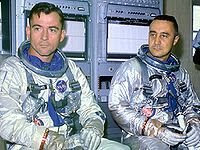Gemini 3 was a 1965 manned space flight in NASA's Gemini program. It was the first manned Gemini flight, the seventh American flight and the 17th manned spaceflight from Earth of all time (includes X-15 flights over 100 kilometers).
Objectives
This first manned flight of the Gemini spacecraft was very much a test flight. In a playful reference to the Broadway hit The Unsinkable Molly Brown, Grissom nicknamed the Gemini 3 spacecraft Molly Brown hoping that it would not duplicate his experience with Liberty Bell 7. It was the last Gemini to be named by an astronaut. All subsequent flights in the program were designated by a Roman numeral.
The mission's primary goal was to test the new, maneuverable Gemini spacecraft. In space, the crew fired thrusters to change the shape of their orbit, shift their orbital plane slightly, and drop to a lower altitude. Other firsts were achieved on Gemini 3: two people flew aboard an American spacecraft (the Soviet Union launched a three-man crew on Voskhod 1 in 1964, upstaging the two-man Gemini and three-man Apollo programs); the first manned re-entry where the spacecraft was able to produce lift to change its touchdown point.
Flight
The only major incident during the orbital phase involved a contraband corned beef sandwich that Young had sneaked on board. The transcript of the crew's conversation during the episode reveals Grissom was unimpressed: (C=Commander Grissom, P=Pilot Young)
01 52 26 C What is it?
01 52 27 P Corn beef sandwich.
01 52 28 C Where did that come from?
01 52 30 P I brought it with me. Let's see how it tastes. Smells, doesn't it?
01 52 41 C Yes, it's breaking up. I'm going to stick it in my pocket.
01 52 43 P Is it?
01 52 49 P It was a thought, anyway.
01 52 51 C Yep.
01 52 52 P Not a very good one.
01 52 52 C Pretty good, though, if it would just hold together.
01 53 13 P Want some chicken leg?
01 53 15 C No, you can handle that. [1]
The crew each took a few bites before the sandwich had to be restowed. The crumbs it released could have wreaked havoc with the craft's electronics, so the crew were reprimanded when they returned to Earth. Other crews were warned not to pull the same type of stunt again.[2]
Launch of the first manned Gemini flightTwo small failures occurred in-orbit. The first was an experiment testing the Synergistic Effect of Zero Gravity on Sea Urchin Eggs. A lever essential to the experiment broke off when pulled. The second involved the photographic coverage objective. It was only partially successful due to an improper lens setting on the 16 mm camera.
Early in the flight there was a minor problem with one of the Orbital maneuvering system thrusters:
00 18 41 C I seem to have a leak. There must be a leak in one of the thrusters, because I get a continuous yaw left.
00 18 53 CC Roger. Understand that you get a continuous yaw left.
00 18 57 C Very slight. Very slow drift. [1]
This is of interest as a similar problem with a stuck thruster in Gemini VIII became much more significant, as Neil Armstrong took some time to regain control of the spinning vehicle. In this mission the problem did not get out of hand, and the thruster was disabled.
The crew made their first orbit change an hour and a half into the flight. The burn lasted 75 seconds and moved them from a 122 by 175 kilometer orbit to a nearly circular one with a drop in speed of 15 metres per second. The second burn was 45 minutes later when the orbital inclination was changed by 0.02 degrees. The last burn came during the third orbit when the perigee was lowered to 72 kilometers. This meant that even if retrorockets had failed, they would still have reentered. When reentry finally occurred, crew commented that even the colours matched ground simulations.
On descent, the capsule shifted from a vertical to horizontal attitude under its parachutes. The change was so sudden that Grissom cracked his faceplate (made of plexiglas) on the control panel in front of him. Later Gemini spacesuits and all Apollo and Space Shuttle (both the launch-entry and EVA suits) used polycarbonate plastic.
The craft landed eventually 84 kilometers short of its intended splashdown point. Wind tunnel testing incorrectly predicted the craft's ability to compensate for course deviation. When the crew discovered the error, they decided to stay in the capsule, not wanting to open the hatch before the arrival of the recovery ship. The crew spent an uncomfortable half an hour in a spacecraft never designed to be a boat. Due to unexpected smoke from the thrusters the crew decided to deviate from the post landing checklist and to keep their helmets on with the face plates closed for some time after splashdown [1]. The USS Intrepid recovered the craft and crew. The Gemini III mission was supported by the following United States Department of Defense resources: 10,185 personnel, 126 aircraft and 27 ships.
Insignia
The mission insignia was not worn by the flight crew as a patch, like those from Gemini 5 onwards. The Gemini 3 Molly Brown logo was designed and minted on gold plated, sterling silver, 1-inch (25-mm) medallions. The crew carried a number of these medallions into space to give to their families and friends. The same design was imprinted on the cover of Gus Grissom's book GEMINI. John Young was seen wearing the Molly Brown logo as a patch on his flightsuit as late as 1981.
Tuesday, May 19, 2009
Subscribe to:
Post Comments (Atom)























No comments:
Post a Comment